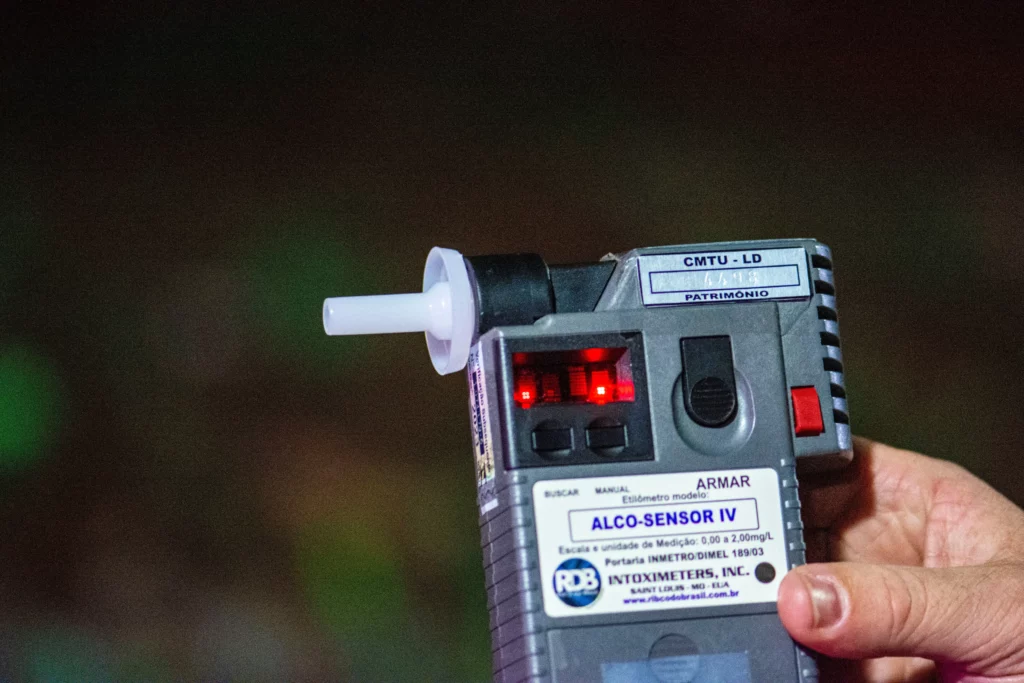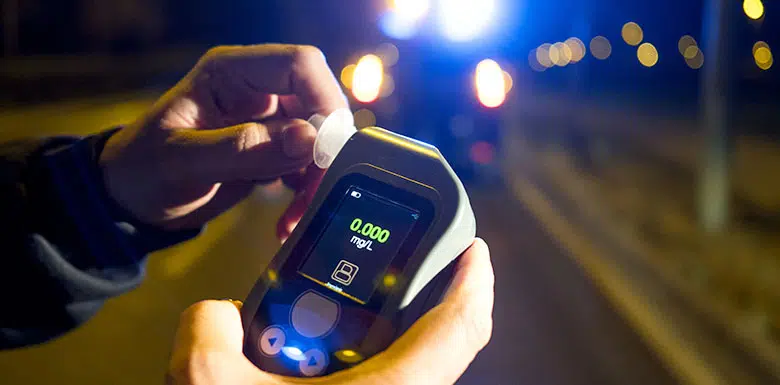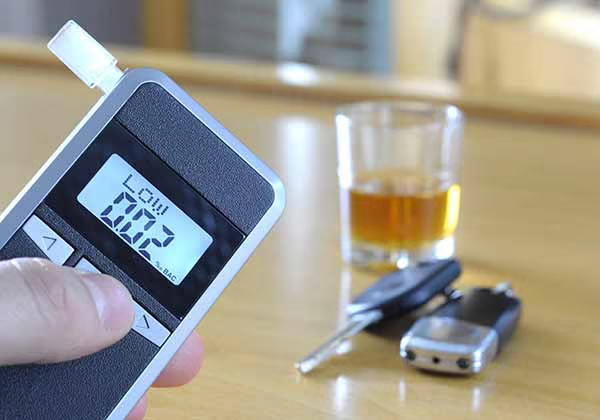How accurate are Breathalyzers? Breathalyzers estimate a person’s blood alcohol concentration from a breath sample and are critical in combating drunk driving.
False positives or inaccuracies can lead to wrongful convictions, while false negatives can endanger public safety.
This article explores breathalyzer reliability, precision factors, and their role in upholding justice and safety.
History and Evolution of Breathalyzers
The use of breathalyzer devices dates back to the early 20th century.
In 1927, Dr. Emil Bogen demonstrated that blood alcohol content could be measured indirectly through breath analysis.
However, it was not until 1954 that the first practical device, the “Drunkometer,” was introduced by Robert F. Borkenstein, a captain in the Indiana State Police.1
This device used a chemical reaction with alcohol to change the color of a solution, providing a visual indication of intoxication levels.
Since then, breathalyzers have undergone significant technological advancements, transitioning from chemical-based solutions to more sophisticated infrared spectroscopy and fuel cell technology.
These improvements have made the devices quicker, more user-friendly, and more accurate, minimizing the margin of error.
As a result, law enforcement agencies can rely on their readings to make informed and just decisions in cases of driving under the influence (DUI).
The evolution of breathalyzers reflects a broader commitment to using technology for public safety.
Advancements in breathalyzer technology enhance our ability to maintain safer roads and a fairer justice system.

Science Behind Breathalyzers
Breathalyzers estimate the Blood Alcohol Concentration (BAC) from a breath sample.
They do this by assuming that the alcohol in the blood diffuses into the air in the lungs, allowing for its measurement in the breath.
When someone drinks alcohol, it is absorbed into the bloodstream and carried to the lungs, vaporizing and becoming part of the air exhaled during breathing.
Breathalyzers typically use infrared spectroscopy or fuel cell technology to detect and measure the amount of alcohol in the exhaled air.
This measurement is converted into a BAC reading through a predetermined ratio, commonly 2100:1.
This ratio means that for every 2,100 units of alcohol in the breath, there is an equivalent unit of alcohol in the blood.
Arizona’s blood alcohol content (BAC) of 0.08 percent is considered the legal threshold for intoxication.2
This equates to roughly two drinks for a woman of average stature and three drinks for a man who weighs more than 200 pounds.
Variables Influencing BAC Readings:
It is essential to understand that several factors can affect the accuracy of BAC readings obtained from breathalyzers.
The individual’s body physiology, such as lung capacity, rate of alcohol metabolism, and body temperature, can significantly impact the concentration of alcohol in the breath.
Furthermore, the timing of the test in relation to when alcohol was consumed is also crucial, as testing too early can result in inaccurately high readings due to residual mouth alcohol.
In addition, some medical conditions like gastroesophageal reflux disease (GERD) or diabetes can produce substances in the breath that are falsely detected as alcohol by some breathalyzers.
It is, therefore, essential to ensure that the device is calibrated and maintained correctly, as poorly calibrated breathalyzers can yield inaccurate results.
Awareness of these variables and their potential impact on BAC readings is crucial when interpreting breathalyzer results accurately and ensuring they serve as reliable indicators in DUI cases.
Types of Breathalyzers
Semiconductor-Based Breathalyzers
Functionality and Typical Applications:
Semiconductor-based breathalyzers use a sensor made of a metal oxide semiconductor that reacts with alcohol in the breath.
When the alcohol interacts with the semiconductor, it changes the sensor’s electrical resistance, which is then converted into a BAC reading.
These smaller and cheaper breathalyzers make them popular for personal use or preliminary screening.
Strengths and Weaknesses in Accuracy:
The main advantage of semiconductor-based breathalyzers is their portability and affordability.
They provide a quick and reasonably accurate way for individuals to estimate their BAC.
However, they are generally less accurate and reliable than other breathalyzers.
They can be sensitive to substances other than alcohol, which may result in false positives.
Additionally, their sensors may deteriorate over time or with frequent use, requiring regular recalibration and possibly reducing accuracy.
Fuel-Cell Breathalyzers
Operating Mechanism and Primary Usage in Law Enforcement:
Law enforcement agencies widely use fuel-cell breathalyzers for roadside testing and DUI enforcement due to their high accuracy and reliability.3
They operate using an electrochemical process where alcohol is oxidized, producing an electrical current proportional to the amount of alcohol present.
This current is then measured and converted into a BAC reading.
Benefits and Potential Limitations:
One of the main benefits of fuel-cell breathalyzers is their specificity to alcohol, resulting in fewer false positives from other substances.
They also maintain their accuracy over time, even with frequent use.
However, they are more expensive than semiconductor-based breathalyzers.
Like all breathalyzers, they require regular calibration and maintenance to maintain accuracy and are not immune to errors from improper use or external factors.
Infrared Spectrophotometry Breathalyzers
Underlying Science and Technology:
Infrared spectrophotometry breathalyzers emit infrared light through a sample of the subject’s breath.
Different molecules in the breath absorb this light at varying wavelengths, and the device measures how much light is absorbed at the wavelength specific to alcohol.
This measurement is then used to calculate the BAC.
This technology is highly sophisticated and commonly utilized in law enforcement and laboratories.
Applicability and Advantages:
Regarding applicability and advantages, infrared spectrophotometry breathalyzers are highly reliable for determining BAC due to their precision and specificity.
They have a significantly low risk of false positives from other substances.
For this reason, they are commonly used in situations where accuracy is paramount, such as in evidentiary testing for DUI cases in court.
However, these devices are relatively expensive and require extensive training to operate correctly.
Additionally, they are less portable than other breathalyzers, making them less practical for preliminary roadside screening.
Despite these challenges, their unparalleled accuracy makes them a vital tool in the fight against drunk driving.
Factors Affecting Accuracy
User Errors
Breathalyzer results can be inaccurate due to user errors.
A common mistake is mishandling the device, which can lead to false readings.
To ensure accurate results, it is important for users to carefully follow the manufacturer’s instructions.
One more mistake is testing too soon after drinking, as alcohol from the mouth or throat can contaminate the breath sample, resulting in a higher BAC reading.
To mitigate this issue, officers typically observe a subject for a specific period to ensure no alcohol is consumed immediately before the test.
For example, someone using mouthwash just before taking a breathalyzer test could cause the device to register a higher BAC due to the alcohol content in the mouthwash.
Device Issues
The accuracy of a breathalyzer can be compromised if the device is not properly calibrated and maintained.
Calibration ensures that the breathalyzer provides accurate readings, which should be done regularly following the manufacturer’s guidelines.
Using outdated models can also lead to inaccuracies, as newer models generally offer improved technology and more reliable results.
Power issues like low batteries can also affect the device’s performance.
A well-known case highlighting the importance of device maintenance occurred in New Jersey in 2018, where over 20,000 DUI convictions were questioned due to improperly calibrated breathalyzers.4
Environmental Variables
Environmental factors such as temperature, humidity, and altitude can influence the accuracy of breathalyzer readings.
For example, extreme temperatures can affect the chemical reactions within the device, leading to incorrect readings.
Similarly, high humidity levels may interfere with the breath sample.
In contrast, high altitudes can alter the ratio of alcohol in the breath to alcohol in the blood, potentially resulting in a lower BAC reading than is accurate.
Understanding these environmental impacts is crucial, especially in regions where such conditions are prevalent.
Physiological Factors
Individual physiological factors play a significant role in the accuracy of breathalyzer results.
Variations in breath patterns, such as hyperventilating or holding one’s breath, can alter the concentration of alcohol in the breath sample.
Health conditions like diabetes or GERD can produce substances in the breath that some breathalyzers may mistakenly identify as alcohol.
Additionally, recent consumption of certain foods or other substances can lead to residual alcohol in the mouth, affecting the accuracy of the reading.
For instance, some protein bars and energy drinks have been reported to cause false positives in breathalyzer tests.
Acknowledging these factors is essential for interpreting breathalyzer results accurately.
Controversies and Legal Implications
Breathalyzers’ precision has been a subject of legal disputes and public discussions.
There have been numerous cases where the accuracy of these devices has been fiercely challenged.
Erroneous readings due to device malfunction, improper calibration, or user error have led to wrongful DUI convictions, putting the credibility of breathalyzers under scrutiny.
This raises concerns about their reliability as evidence in court, which goes beyond the legal realm, infringing upon individual rights and undermining trust in justice processes.
Inaccurate readings can result in unjust penalties, including fines, license suspensions, and even imprisonment, affecting an individual’s personal and professional life in the long run.
Stringent calibration protocols, regular maintenance, and proper training for users become critical in safeguarding the integrity of DUI testing and ensuring that justice remains balanced.
The 2009 case in Washington, D.C., where hundreds of DUI convictions were questioned due to breathalyzer calibration errors, highlights device accuracy’s profound implications on legal outcomes and individual liberties.5
Best Practices for Ensuring Accuracy
Routine Calibration and Upkeep of Devices
Ensuring the accuracy and reliability of breathalyzer devices requires regular calibration and proper maintenance.
Calibration involves adjusting the device to a known standard using a solution that simulates a specific BAC level.
This guarantees that the breathalyzer provides precise readings across a range of alcohol concentrations.
Proper upkeep, such as cleaning and checking the device for wear and tear, further ensures optimal performance.
Neglecting these practices can lead to accuracy drift over time, potentially resulting in false positives or negatives.
A breathalyzer that is not calibrated regularly may show a higher BAC than is accurate, leading to unjust legal consequences for the individual being tested.
Comprehensive Training for Test Administrators
The individuals administering breathalyzer tests must undergo comprehensive training to understand how to use the devices and interpret the results correctly.
This training should cover the proper procedures for administering the test, how to deal with scenarios that might arise during testing, and how to maintain the breathalyzer to ensure accuracy.
Administrators should be trained to observe the subject for a certain period before conducting the test to reduce the likelihood of mouth alcohol affecting the results.
Failure to properly train test administrators can result in user errors that compromise the accuracy of the breathalyzer, potentially leading to legal challenges and incorrect DUI convictions.
Implementation of Waiting Durations and Retesting
To further enhance the accuracy of breathalyzer results, it is best practice to implement waiting periods before conducting the test and to perform retesting when necessary.
Waiting periods help to ensure that any residual mouth alcohol has dissipated, providing a more accurate representation of the subject’s BAC.
Conducting a second test after a short period can help to validate the outcomes of the first test.
If the two results are significantly different, it may indicate that the first test was affected by residual mouth alcohol or another factor, and further investigation may be necessary.
Implementing these practices helps to safeguard against false readings and ensures that the results are reliable and can be confidently used in legal proceedings.
Did You Get a DUI?
Understanding the Next Steps
Dealing with a DUI arrest can be daunting as it involves several legal procedures.
After arrest, the individual is usually taken into custody, their vehicle is impounded, and a breathalyzer test is conducted.
Suppose the breathalyzer test reveals a Blood Alcohol Concentration (BAC) exceeding Arizona’s permissible limit of 0.08 percent. In that case, the individual in question will face charges and be mandated to attend a court hearing.
They have the option to hire a lawyer to help them navigate the legal proceedings which typically involve pre-trial motions, plea bargains, and possibly a trial.
It is essential to seek legal help to protect the individual’s rights throughout the legal process.
An attorney can challenge the accuracy of the breathalyzer test or argue for reduced penalties based on the circumstances of the arrest.
For instance, if the breathalyzer was not calibrated properly, the lawyer may argue to dismiss the results as evidence.
| Step | Details |
|---|---|
| 1. DUI Arrest | Based on observed behaviors, field sobriety tests, or preliminary breath test results, the individual is taken into custody on suspicion of driving under the influence. |
| 2. Booking and Bail | The individual is booked at the police station, including recording personal information, taking fingerprints, and possibly photographing. Bail may be set, allowing for release from custody until the court date. |
| 3. Arraignment | The individual appears in court, is informed of the charges, and enters a plea (guilty, not guilty, or no contest). |
| 4. Pre-Trial Motions & Hearings | The defense and prosecution may file motions, gather evidence, and have hearings to determine the admissibility of evidence and other legal matters. |
| 5. Plea Bargaining | The defense and prosecution may negotiate to reach a plea agreement, which could result in reduced charges or penalties in exchange for a guilty plea. |
| 6. Trial | If no plea agreement is reached, the case goes to trial, where both sides present their evidence and arguments. A judge or jury then determines the verdict. |
| 7. Sentencing | If found guilty, the individual is sentenced by the judge. This could include fines, jail time, community service, DUI education classes, or other penalties. |
| 8. Post-Trial Motions & Appeals | The defense can file post-trial motions, and if the verdict is guilty, they may appeal to a higher court. |
| 9. Completion of Sentencing | The individual must complete all court-ordered penalties and requirements. Failure to comply could result in additional penalties. |
Alcohol Screenings:
These screenings are crucial as they help decide the appropriate legal and rehabilitation measures.
In Arizona, for instance, alcohol screenings are mandatory for anyone convicted of DUI.
They play a vital role in the subsequent sentencing and determining the need for alcohol education or treatment programs.
These screenings can be conducted in person or online, providing accessibility and convenience.
For online screenings in Arizona, it’s imperative to ensure that the provider is state-approved and the court will accept the results.
We offer Arizona-approved alcohol screenings that meet court requirements.
DUI Education Classes:
These classes aim to educate participants about the dangers of impaired driving, the impact of alcohol on the brain and body, and the ways to make safer choices in the future.
In many jurisdictions, completing a DUI education program is a mandatory part of the legal penalties for DUI and is necessary to reinstate driving privileges.
In Arizona, for example, completing DUI classes is a standard requirement, and the curriculum is designed to prevent future incidents of impaired driving.
These classes not only fulfill legal obligations but also significantly reduce the likelihood of repeat offenses, contributing to overall road safety.
Finding Trusted Providers:
Choosing a reputable and certified provider for DUI-related services in Arizona is crucial to ensure that the programs meet the state’s legal requirements and genuinely aid in rehabilitation.
When searching for alcohol screening or DUI education providers, verifying their accreditation and confirming that they are recognized by the Arizona Department of Transportation (ADOT) or the respective state authority is essential.
Seeking recommendations from legal professionals or individuals who have undergone similar programs can provide valuable insights.
Additionally, researching online reviews and testimonials can help gauge the credibility and effectiveness of the provider.
Ensuring that the institution maintains a high standard of professionalism, confidentiality, and integrity is vital, as this directly impacts the quality of the services received and the fulfillment of legal obligations.
Cornerstone DUI is a trusted provider of Arizona DUI Services.

The Future of Breathalyzer Technology and DUI Rehabilitation
The journey of breathalyzer technology, from its inception to its current state, has been remarkable in innovation and refinement.
Today, the devices are much more sophisticated and reliable than their predecessors, providing crucial data in the fight against drunk driving.
However, the quest for precision remains ongoing, underscoring the importance of continued research and advancements to enhance the accuracy and reliability of these devices.
For those dealing with the aftermath of a DUI, it is crucial to participate in necessary screenings and education programs.
These steps are legal requirements and vital in promoting awareness, responsible behavior, and ultimately contributing to safer roadways for everyone.
By proactively engaging in these programs, individuals can take significant steps towards rehabilitation and building a brighter, more conscious future.
MVD-Approved DUI Services and Alcohol Treatment
Cornerstone DUI is a certified provider of DUI Services in Arizona, committed to providing personalized care to help you achieve lasting recovery.
If you’re facing DUI charges, we’re here to support you.
We offer online services that allow you to work towards a brighter, healthier future on your terms.
Our MVD-approved DUI classes, screenings, and assessments are convenient and flexible, and we offer the most competitive prices.
Take the first step towards recovery and DUI resolution today!






